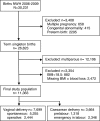Maternal obesity and postpartum haemorrhage after vaginal and caesarean delivery among nulliparous women at term: a retrospective cohort study
- PMID: 23078042
- PMCID: PMC3495044
- DOI: 10.1186/1471-2393-12-112
Maternal obesity and postpartum haemorrhage after vaginal and caesarean delivery among nulliparous women at term: a retrospective cohort study
Abstract
Background: Increasing rates of postpartum haemorrhage in developed countries over the past two decades are not explained by corresponding changes in risk factors and conjecture has been raised that maternal obesity may be responsible. Few studies investigating risk factors for PPH have included BMI or investigated PPH risk among nulliparous women. The aim of this study was to determine in a cohort of nulliparous women delivering at term whether overweight and obesity are independent risk factors for major postpartum haemorrhage (PPH ≥1000ml) after vaginal and caesarean section delivery.
Methods: The study population was nulliparous singleton pregnancies delivered at term at National Women's Hospital, Auckland, New Zealand from 2006 to 2009 (N=11,363). Multivariable logistic regression was adjusted for risk factors for major PPH.
Results: There were 7238 (63.7%) women of normal BMI, 2631 (23.2%) overweight and 1494 (13.1%) obese. Overall, PPH rates were increased in overweight and obese compared with normal-weight women (n=255 [9.7%], n=233 [15.6%]), n=524 [7.2%], p <.001) respectively. There was an approximate twofold increase in risk in obese nulliparous women that was independent of confounders, adjusted odds ratio [aOR (95% CI)] for all deliveries 1.86 (1.51-2.28). Being obese was a risk factor for major PPH following both caesarean 1.73 (1.32-2.28) and vaginal delivery 2.11 (1.54-2.89) and the latter risk was similar after exclusion of women with major perineal trauma and retained placentae. Three additional factors were consistently associated with risk for major PPH regardless of mode of delivery: increasing infant birthweight, antepartum haemorrhage and Asian ethnicity.
Conclusion: Nulliparous obese women have a twofold increase in risk of major PPH compared to women with normal BMI regardless of mode of delivery. Higher rates of PPH among obese women are not attributable to their higher rates of caesarean delivery. Obesity is an important high risk factor for PPH, and the risk following vaginal delivery is emphasised. We recommend in addition to standard practice of active management of third stage of labour, there should be increased vigilance and preparation for PPH management in obese women.
Figures
Similar articles
-
Postpartum haemorrhage in women with mild factor XI deficiency.Haemophilia. 2020 Jul;26(4):663-666. doi: 10.1111/hae.14081. Epub 2020 Jun 17. Haemophilia. 2020. PMID: 32558038
-
Differential effects of different delivery methods on progression to severe postpartum hemorrhage between Chinese nulliparous and multiparous women: a retrospective cohort study.BMC Pregnancy Childbirth. 2020 Oct 31;20(1):660. doi: 10.1186/s12884-020-03351-7. BMC Pregnancy Childbirth. 2020. PMID: 33129300 Free PMC article.
-
Predicting risk of postpartum haemorrhage during the intrapartum period in a general obstetric population.Eur J Obstet Gynecol Reprod Biol. 2022 Sep;276:168-173. doi: 10.1016/j.ejogrb.2022.07.024. Epub 2022 Jul 29. Eur J Obstet Gynecol Reprod Biol. 2022. PMID: 35917716
-
Aetiology and treatment of severe postpartum haemorrhage.Dan Med J. 2018 Mar;65(3):B5444. Dan Med J. 2018. PMID: 29510809 Review.
-
Active management of the third stage of labour: prevention and treatment of postpartum hemorrhage.J Obstet Gynaecol Can. 2009 Oct;31(10):980-993. doi: 10.1016/S1701-2163(16)34329-8. J Obstet Gynaecol Can. 2009. PMID: 19941729 Review.
Cited by
-
Risk Factors and Outcomes Associated with Maternal Obesity and Overweight: A Cross Sectional Study among Moroccan Women in Marrakech.Iran J Public Health. 2024 Apr;53(4):846-854. doi: 10.18502/ijph.v53i4.15561. Iran J Public Health. 2024. PMID: 39444465 Free PMC article.
-
Use of antidepressants near delivery and risk of postpartum hemorrhage: cohort study of low income women in the United States.BMJ. 2013 Aug 21;347:f4877. doi: 10.1136/bmj.f4877. BMJ. 2013. PMID: 23965506 Free PMC article.
-
Gestational weight gain among pregnant women in Ibadan, Nigeria: Pattern, predictors and pregnancy outcomes.PLoS One. 2023 Aug 18;18(8):e0290102. doi: 10.1371/journal.pone.0290102. eCollection 2023. PLoS One. 2023. PMID: 37594997 Free PMC article.
-
Predictors of Postpartum Hemorrhage and Associated Outcomes at a Midwest Academic Medical Center.Womens Health Rep (New Rochelle). 2024 Apr 26;5(1):358-366. doi: 10.1089/whr.2023.0192. eCollection 2024. Womens Health Rep (New Rochelle). 2024. PMID: 39035139 Free PMC article.
-
Comparison of perioperative outcomes and anesthetic-related complications of morbidly obese and super-obese parturients delivering by cesarean section.Ann Med. 2023 Dec;55(1):1037-1046. doi: 10.1080/07853890.2023.2187877. Ann Med. 2023. PMID: 36947155 Free PMC article. Clinical Trial.
References
-
- Callaghan WM, Kuklina EV, Berg CJ. Trends in postpartum hemorrhage: United States, 1994–2006. Am J Obstet Gynecol. 2010;202(4):353. e351-356. - PubMed
-
- Knight M, Callaghan WM, Berg C, Alexander S, Bouvier-Colle M-H, Ford JB, Joseph K, Lewis G, Liston RM, Roberts CL. et al.Trends in postpartum hemorrhage in high resource countries: a review and recommendations from the International Postpartum Hemorrhage Collaborative Group. BMC Pregnancy Childbirth. 2009;9:55. doi: 10.1186/1471-2393-9-55. - DOI - PMC - PubMed
-
- (CMACE) CfMaCE. Maternal obesity in the UK: Findings from a national project. London: CMACE; 2010.
Publication types
MeSH terms
LinkOut - more resources
Full Text Sources
Medical
Miscellaneous



